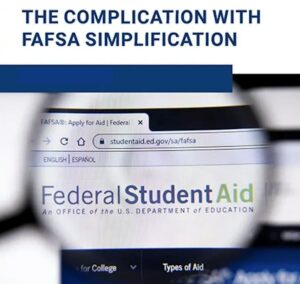September College Newsletter
This Month’s Highlights:
-
- A New FAFSA Form is Coming– Don’t File Until You Read This
- Major Changes in College Aid
- Financial Aid Insider: One Hack To Increase Financial Aid

There is a new sheriff in town, and a whole new supporting cast of characters.
I’m kidding of course, but there is a new FAFSA coming your way. You may have heard that if you don’t want to miss out on financial aid you have to get your FAFSA in early. Well, that’s not going to happen this year.
Typically, the FAFSA is available on October 1st. But this year, the Department of Education is saying sometime in December. But I think January 1, 2024 is more likely.
When it does go online, we advise not jumping the gun to complete it right away. You’d be a guinea pig, and I’m sure you don’t want to be experimented on! The fact that everything will be completely brand new is reason enough to avoid submitting a FAFSA for at least the first two weeks.
This is because the FAFSA Simplification Act is in its final phase of implementation of the new FAFSA for the 2024-2025 school year, and there are 20 different systems connected to it.
What are the odds that the government makes a tectonic shift in rules, regulations, formulas, forms, websites, etc., and does it with a slashed budget and staff cuts has a chance to be bug free? Healthcare.Gov anyone?
If you’re concerned or worried about your student missing Early Decision, Early Action, or state grant deadlines, don’t be. Colleges and states are already postponing the deadlines by at least a couple of months.
Changes to Financial Aid

FAFSA Simplification is anything but simple.
The first change is the formula used to determine how much aid a student is eligible for. This is the last year (2023-2024) that the federal needs analysis formula will calculate an Expected Family Contribution (EFC). From 2024-2025 onward, that formula is called the Student Aid Index (SAI). The new SAI will be based on much of the same information as the old EFC. But, for many middle to upper income parents, the results will be painful (costly).
Divorced and Separated Parents
It used to be the parent the student lived with more than 50% of the time completed the FAFSA. For example, if one parent made considerably less than the other, the FAFSA would favor the parent making less. The result being that financial aid eligibly would be higher.
Now, the rules require that the parent who provides the majority of material support is the one to complete the FAFSA. This does not necessarily mean that the parent who makes the most money is automatically the parent who files.
Discount Based on Number of Students Enrolled in College Is Gone
For almost 30 years, the Federal Methodology that produced the EFC has discounted that the number of students in college at the same time by 50% or more, depending on the number in college. The removal of this discount will be harsh and possibly devastating to many families.
The new rationale is that the discount wasn’t fair to those parents with only one student in college. But that’s flawed thinking. If a parent has three in college at the same time, the cost would be the same as a parent with one in college. 
Families with more than one student in college will in many cases be eligible for less financial aid. That said, we expect the CSS Profile will continue to consider the number of students a family has in college. The CSS Profile is a form used by 200 of the more to most selective colleges used to award their own money.
It’s hard to imagine that parents with multiple students currently in college at the same time losing their aid. That would be bad business for colleges. It’s likely that the multiple discount will be grandfathered. However, that’s no guarantee, and parents should be prepared to appeal based on multiple students in college at the same time.
Family Businesses and Farms Are Now Counted

In past years, the net worth of a family small business with fewer than 100 employees was not reported. Starting with the 2024-2025 FAFSA, the net worth of each will be part of the FAFSA calculation.
Here’s an example of how devastating this can be to families who would otherwise qualify for a good deal of financial aid.
Without including the business or farm, a family earning $100,000 could expect an EFC of $20,000.
Add a business or farm with a valuation of one million dollars and see what happens: A forulaic adjustment reduces the net worth of $1,000,000 to $666,000. Then multiply $666,000 by an assessment rate of 5.64%. That increases the new SAI by $37,562! What was once a contribution of $20 thousand is now almost three times as much at over $57 thousand!

For many parents with a business or farm, that means the end of any need-based financial aid (grants, some scholarships) for their student. It may even be the end of their ability to afford college.
Parents who don’t own either a business or a farm may say, “Well, that’s fair. They have money.” But, the truth is that to get the equity out of a business to pay for college, or to borrow money against the equity of a farm is usually not possible. There is an expression: “Land rich and cash poor”. That’s the situation of most closely held businesses and farms.
However, with foresight and planning the value of both can be eliminated. That’s something you will want to discuss with your financial advisor as soon as possible.
|
|
|
A Hack To Increase Financial Aid Eligibility
The following sentence is long, so please bear with me. 
The old EFC formula had retirement contributions added back into income that would go on the FAFSA and reduce eligibility. However, if you have earned income, the kind that generates a W-2 form, and you make contributions to your employer sponsored retirement plan; i.e., 401k, 403b, or 457b, that income will no longer be counted. This is a big change in parents’ favor.
But, if you make contributions to an IRA, SIMPLE IRA, SEP IRA OR Keogh Plan, that income will be added back into the SAI formula.
If you’re asking why that is here is the answer: The W-2 deduction is not part of the IRS 1040. StudentAid.Gov apparently has no interest in any income that doesn’t appear on the 1040.
If you are a business owner who doesn’t get a W-2, it could make sense to contact us for a consultation and learn how to get that deduction from the financial aid formula.
Don’t Pay Full Price
There are more trapdoors and landmines than ever before. Do everything you can to avoid mistakes by preparing now for the financial aid process.
If you aren’t a client already, please contact us at 951-465-6409 to schedule a consultation to discuss your personal circumstances to learn ways you may be able to reduce your college costs.
‘Till next time, if you can go leaf peeping.
Bob Chitrathorn
P.S. If you find this newsletter helpful, please share it with others like yourself!
Disclosures
This material was created to provide accurate and reliable information on the subjects covered but should not be regarded as a complete analysis of these subjects. It is not intended to provide specific legal, tax or other professional advice. The services of an appropriate professional should be sought regarding your individual situation


 Each month, we provide you with tips on your best ways to pay for college regardless of your financial situation.
Each month, we provide you with tips on your best ways to pay for college regardless of your financial situation.
CONNECT WITH BOB